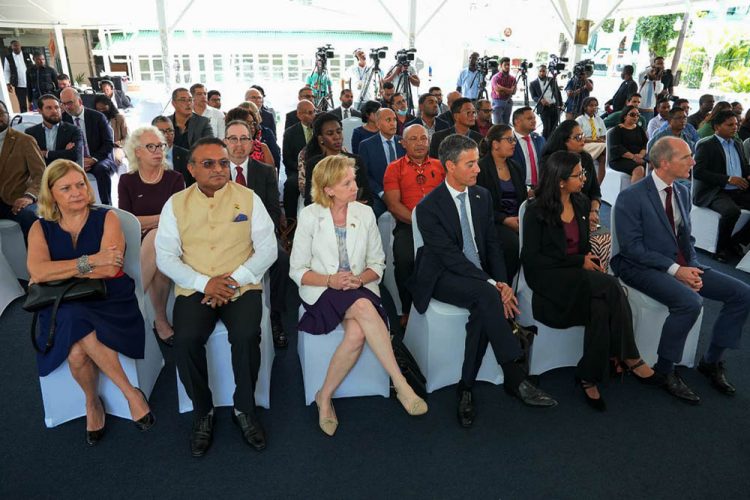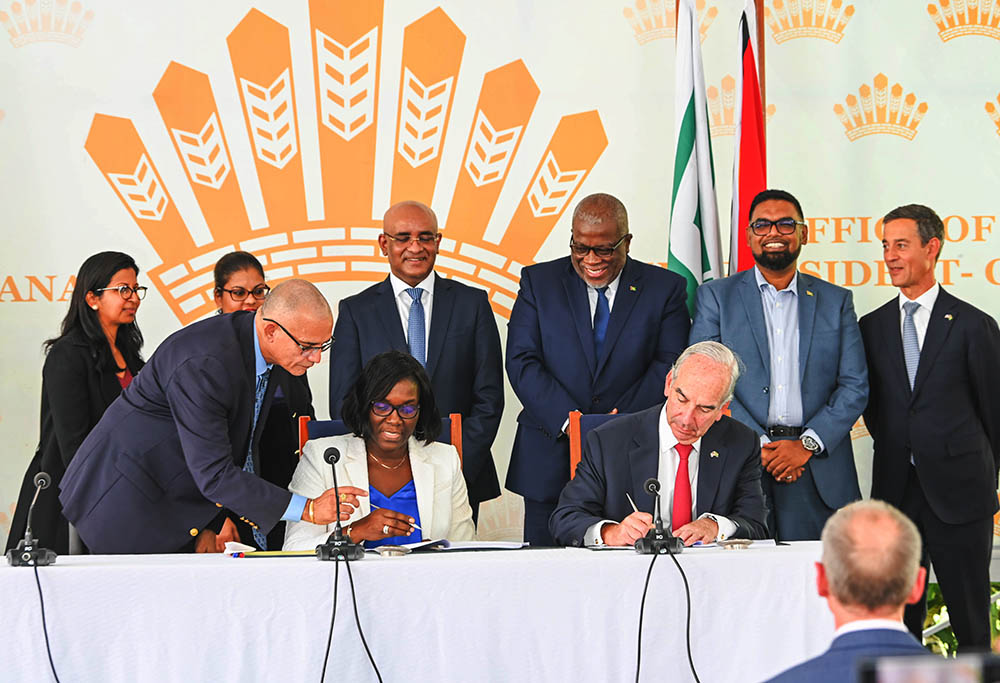Hess Corporation, one of the partners in Guyana’s lucrative offshore oil block, yesterday announced the purchase of US$750m of this country’s carbon credits over 10 years and 15% of the monies will go to Indigenous communities.
The Hess purchase followed an announcement on Thursday by the Architecture for REDD+ Transactions (ART) of the issuance of over 33 million carbon credits to this country. Hess will purchase the first 30 per cent of that amount for a minimum of US$750 million over a ten-year period.
However, while the agreement period between the two partners is from 2022 to 2032, government says that it was able to negotiate a ‘legacy credit’ amount of 12.5 million credits at US$15 per tonne, thus receiving a US$187 million sum for the period 2016 to 2020. In two weeks, US$75 million of that amount will be deposited into the account and the remainder paid within 18 months.

All the monies will be deposited into the special Carbon Credits account and used on projects and programmes, designed for Guyana’s climate mitigation efforts in its Low Carbon Development Strategy (LCDS). However, 15 per cent of all deposits will be dedicated to fund developmental projects for Indigenous communities.
“Today we are signing a historic agreement with Hess who will buy 2.5 million credits per year. This agreement represents credit between 2016 and 2030 to a value of US$750 million. It is historic…” President Irfaan Ali yesterday remarked alongside President of Hess, John Hess, who flew into the country for the agreement signing.
To a packed Baridi Benab at State House where members of the diplomatic community, private sector, and civil society were present, Ali underscored that combating climate change has always been and will continue to be a priority area for his government, albeit being an oil producing country. And if Guyana can earn revenue for its green resources simultaneously, then, he said, it will explore all environmentally sound avenues to maximize on it.
He pointed to the PPP/C’s flagship environmental policy plan in the Low Carbon Development Strategy and reflected on how strategies in it allowed this country to gain revenue from its forests over the years, through a US$250m agreement with the Kingdom of Norway.
But while it was designed to be a continuous programme, payments ceased in 2015.
“In 2009, Guyana produced the first low-carbon development strategy from a developing country. As one of only nine national jurisdictions in the Amazon Basin, we said long ago that national or jurisdiction-scale action on forests, coupled with access to global private finance, could create solutions that benefit the peoples of forest-rich countries while also achieving global climate goals. We have stayed the course, and today’s signing represents a massive step forward in showing the world that developing countries can lead the way to global solutions. I thank the tens of thousands of people across Guyana who participated in the seven-month national consultation that culminated in our latest LCDS policy, LCDS 2030,” the president was quoted as saying. Ali also thanked Hess for stepping up and making payments retroactively for credits for the time none was earned.
“We thank Hess for their part in exercising this great responsibility and being part of the solution as we confront the challenges of climate change and protecting our forests. It is important to note how important good governance and strong leadership is. And I do not say that lightly. As you know, we were not in government between 2015 and 2020. The agreement with Norway was signed before that. Our credentials on climate change and the forests was known all across the globe. Unfortunately, we lost that credential because of [lack of] commitment. Today we have shown that the opportunity existed even then. Because in this agreement that we signed today the 12.5 million credits is what is being termed legacy credit. We have been able to go back to 2016 and 2020, the period you’re out of government and get legacy credit sold between 2016 and 2020.”
Vice President and former president, Bharrat Jagdeo, who formulated the LCDS was lauded by Ali, who credited him for crafting yesterday’s agreement. Jagdeo was singled out as the first president from a developing country to develop a low-carbon development strategy.
Jagdeo explained the history and technical perspectives behind the project and was quick to point out that the monies will be channeled back into environmental projects.
“We hope that in 18 months, all of these resources will come to us. In fact, the payment schedule shows that in 18 months, we’ll receive the full [US]$187 million. US$28 million dollars of that will go to the Amerindian communities. We made a commitment that 15 per cent of all of the proceeds from any sale of forest carbon will go to Amerindian communities. We had a discussion at the NTC [National Toshaos Council], [and] we agreed that all of the communities, forested and non-forested, [that] Amerindians will benefit in an equitable manner and they will decide on the distribution. So [US]$28 million of that will go to these communities…,” he said.
Boundaries
Critics have already raised concerns over such agreements and what they mean for Indigenous communities, which may not directly benefit from the control and sale of carbon credits from the forest within the boundaries of their titled lands.
“For the period 2021 to 2025 in the agreement, it’s $20 per ton and we anticipate another $250 million there. And the period 2025 to 2030, it’s $25 per ton and will be about 312 million for a total of $750 million. But it’s only 30% of our total credit for the period. So the Amerindian communities from this deal alone with us … will benefit from about, get about 112 million US dollars. That’s a lot of money,” Jagdeo said.
Revenues received by Guyana will be deposited into an account that will be audited annually by an independent international auditor, according to Jagdeo, and this will make for easy spending as compared to the burdensome processes as with the Norway funds. “All the funds will be in one account… which will be reported to parliament and there will be an international audit of the account. So it is under our control now as compared to the past where you had to go through a multilateral agency,” he explained.
“The money will come into the treasury as revenue and will be in a separate account so that the Auditor General and everyone and parliament and so on can be notified of these [funds].
He said that while Guyana has about US$85 million left to collect from the Norway funds, the process to collect it can be likened to having to “jump through hoops” since the agency which is holding it “treats it like a regular loan.”
“You are supposed to only ensure transparency, not to have us justify us using our own money again,” the Vice President lamented, a grouse which extends to his last term in office as President which ended in 2011. Oslo had insisted on intermediaries such as the World Bank and the Inter-American Development Bank to oversee the expenditures.
Jagdeo said that the credits will be on the ART registry and will be independently verified to represent permanent and additional emissions reductions under ART’s REDD+ Environmental Excellence Standard 2.0 (TREES). “They will be independently verified as meeting all relevant United Nations social and environmental safeguards – including those relating to protecting the rights of Indigenous peoples and local communities,” government also said in a statement.
For his part, President of Hess, John Hess, pointed out that the decision to enter the agreement was one founded on his company’s own goals as it forges ahead to its 2050 net zero emissions target by 2050.
“The Government of Guyana and Hess have established a carbon credits purchase agreement in which Hess will invest a minimum of US$750 million between 2022 and 2032, to purchase high quality, independently verified, REDD-plus carbon credits directly from the Government of Guyana and it is an historic agreement…,” he said
“The carbon credits purchase agreement we are announcing today highlights Guyana’s global leadership in avoided deforestation and underpins Guyana’s low carbon development strategy. This agreement adds to our company’s ongoing and successful emissions reduction efforts, and is an important part of our commitment to achieve net zero and to achieve Net Zero scope one and scope two greenhouse gas emissions by 2050. Many companies, many countries make pledges about net zero. We actually are showing action, the country of Guyana is showing action and steps to make 2050 Net Zero a reality,” he added.
Hess stated that his country remains committed to ensuring that Guyana’s carbon sink status continues.
On Thursday, the Arlington, Virginia, US-based ART issued Guyana over 33 million carbon credits which paves the way for lucrative earnings from the country’s carbon storage potential.
The credits are certified based on ART’s standard for measurement, monitoring, reporting and verification, The REDD+ Environmental Excellence Standard, known as TREES.
ART said the approval of 33.47 million TREES credits was granted to Guyana following completion of an independent validation and verification process and approval by the ART Board of Directors.
Guyana’s TREES credits are also the first market-ready credits issued to a jurisdiction classified as “High Forest, Low Deforestation” (HFLD), the statement said, explaining that this has high forest cover and low historical rates of deforestation.
Carbon markets have historically focused predominantly on areas that have already experienced high rates of deforestation. This is now starting to change with the first TREES credits issued to Guyana.
Prior to the crediting approach in TREES, there had not been a market-oriented approach that allows HFLD jurisdictions to benefit from carbon market finance.
The HFLD crediting approach in TREES recognises that HFLD jurisdictions must continue to aggressively protect forests to avoid deforestation and degradation, and that carbon market finance can be a powerful incentive to help achieve this. All HFLD credits are tagged as such on ART’s public registry, the statement added.
On its website, ART describes itself as a standalone, independent programme that develops and administers standardized procedures for crediting emission reductions and removals from national and large sub-national REDD+ programmes.
ART says it is governed by a Board of globally recognized experts and operated by an independent Secretariat, hosted by Winrock International.
“ART’s standard for the measurement, monitoring, reporting and verification of emission reductions and removals from the forest sector — The REDD+ Environmental Excellence Standard, known as TREES — represents the next step in the evolution of global efforts to protect and restore tropical forests”, the website said.
It added that it is governed by an independent Board of Directors whose members represent a diverse group of objective, globally recognized experts.





